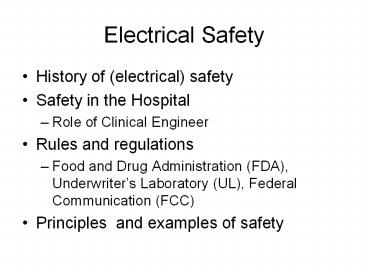Electrical Safety PowerPoint PPT Presentation
1 / 18
Title: Electrical Safety
1
Electrical Safety
- History of (electrical) safety
- Safety in the Hospital
- Role of Clinical Engineer
- Rules and regulations
- Food and Drug Administration (FDA), Underwriters
Laboratory (UL), Federal Communication (FCC) - Principles and examples of safety
2
Physiological Response to Electricity
- Electrical shock from devices in the home to
lightening - Macroshock (lightning, instruments)
- Microshock (implantable catheters, leakage)
- Susceptibility Parameters Frequency, Duration,
Body weight, Point-of-entry
3
Frequency Susceptibility
- Note the thresholds for preception, let-go
currents.
4
Duration/Body Weight Susceptibility
- Strength-duration curve is a very important plot,
applicable to shocks, pacemaker/defibrillator
type devices, etc. - Note the chronaxie point (at the lower left
corner of each curve)
5
Current vs. Frequency
- Difference in DC vs AC shocks
- Note that the threshold is lowest at the
powerline frequencies! - Very high threshold/low sensitivity at high
frequencies used in many medical applications - impediance check, respiration, communications.
6
Isolated-Power Systems
- Transformer isolation
Transformer isolation used in hospital based
clinical instruments Isolation of power supply
and also of the instrument/circuit
7
Isolated-Power Systems
- Optical Isolation
Simple LED, photodiode circuit
Advanced circuit for linearization from the book
Optical isolation is used in simple
instrument/circuit designs e.g. interfacing ECG
amplifier to the outside world optical path
provides break of electrical continuity usually
interrupting path to ground for the leakage
current
8
Micro- vs. Macroshock Hazards Points of Entry
- Microshock occurs because there is a low
resistance invasive path to the heart - Note the path to ground in any microshock circuit
- Microshock due to ventricular fibrillation
- Lowered safety in hospital, bathroom
9
Sources of Microshock
- Failure of power outlet,cord
- Failure of transformer
- Failure of catheter/lead
- Ground path and ground loop leakage
10
Sources of Macroshock
- Direct contact to Live power supply
- Live instrument chassis
- Failed transformer
- Electrical spark/discharge
- Lightning
11
Conductive Paths to the Heart
- Pacemaker Leads
- Epi- or endocardial electrodes
- Intracardiac electrogram (EGM) electrodes
- Liquid-filled Catheters for
- Blood pressure monitoring
- Blood sampling
- Drug/dye injection
- Ground loop and inadvertent leakage path
12
Safety Codes Standards
- NFPA 99
- Standard for Health Care Facilities
- National Electrical Code
- Article 517 Health Care Facilities
- Association for the Advancement of Medical
Instrumentation (AAMI) - Developed American National Standard on Safe
Current Limits for Electromedical Apparatus
13
Leakage Current Limits
14
Protection Circuits
Pole-to-opposite pole. Figure 2A depicts the
circuit path when a man simultaneously touches
both poles of the floating or isolated circuit.
In this situation, there is no insulation. The
current is limited only by the impedance of the
body. http//www.ewh.ieee.org/soc/emcs/pstc/Tec
hSpk/floating.html
15
Protection Circuits
If we interpose an insulating barrier between one
pole of the floating circuit and the man, then we
can define that barrier as Basic Insulation. In
the event of failure of that Basic Insulation,
there is no electric shock current in the man. If
we extend that same insulation such that it is
interposed between the OPPOSITE pole and the man,
then we can define the OPPOSITE pole portion of
the insulation as Supplementary Insulation
(because it provides insulation against the
SECOND body connection). http//www.ewh.ieee.org/
soc/emcs/pstc/TechSpk/floating.html
16
References
- Webster, JG (1998). Medical Instrumentation.
John Wiley Sons, Inc., New York, NY. Chapters
1 14. - Nute, R (1998). Floating circuits protection
against electric shock. In Technically Speaking
section of Product Safety Technical Committee
Newsletter (online). - http//www.ewh.ieee.org/soc/emcs/pstc/TechSpk/
17
Problems
- Describe a sensor or a measurement system in
which accuracy is important. In contrast,
describe a sensor or a measurement in which
precision is important. - A temperature sensor, such as a thermistor can
be described by a first order system. Write down
the general equation for a first order system
(you can write a differential equation or a
transfer function). - Plot the output of the first order system in
response to a step change in temperature. - A blood pressure sensor is described by a
second order system. Write down the general
equation for a second order system (you can write
a differential equation or a transfer function).
- Plot the output of the second order underdamped
pressure system in response to a blood pressure
signal.
18
PROBLEMS
- Draw the circuit of a differentiator OR
integrator. - Now, through circuit analysis show why that
circuit works like a differentiator/integrator
(i.e. derive the relationship between output and
input of the amplifier to show using your
equation that the input signal is
differentiated/integrated. - Next, obtain the frequency response of this
circuit. E.g. you can derive a transfer function
(output over input) in the Laplace form,
substitute sjw and then show the frequency
response. - Point out one major advantage and one major
disadvantage of an analog differentiator/integrato
r over a digital/software version. - Describe (very briefly) a biomedical
instrumentation application of an integrator or
differentiator.

